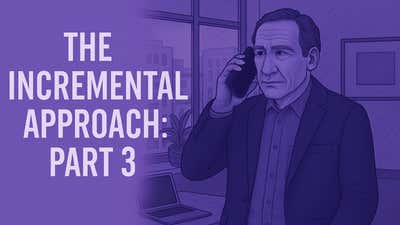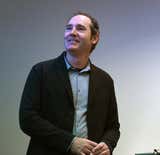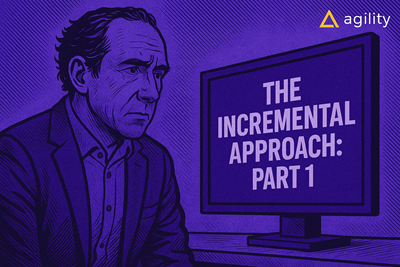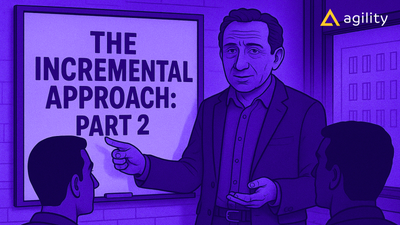The Incremental Approach: Go To Market in Less Than Half the Time - Part 3
Everyone Wants You to Come Through


Where We Left Off: My intrepid team and I brainstormed ideas on how to get the client's site back online ASAP. Using a CDN was the best choice, but that could take months - time we just didn't have. We could turn on the CDN as a stop-gap, but we need the client's support. This could work. Or blow up in my face.
“Tell me good news, Joel,” he said. His voice was hoarse.
“How soon can you update your DNS,” I asked. “We can put the site on a CDN to get it back up and running.”
He didn’t hesitate before saying he could get it done in less than an hour. I put him on mute.
“Ben,” I asked. “What’s the impact of turning on this CDN right now?”
“Well,” he pondered, the site has a bunch of authenticated sections and stuff that needs to be dynamic, so we can’t fully take advantage of the CDN, to be honest.”
I unmuted the phone.

“Here’s what we can do,” I said. “Tom is going to email you instructions for updating your DNS to point to the CDN. We’re going to cache your homepage ONLY for now just so the whole site isn’t down. We’ll get back to you on the plan for everything else.”
“Make it quick,” he said. “I just got notified that this thing is going to be national news at 6pm.”
He hung up.
For a minute there was only the sound of Tom typing away as he sent the settings over to the customer.
“He didn’t even say thanks for giving him a solution,” said Terri, sounding miffed.
“He’s feeling a ton of pressure,” I said. “And it’s our job to keep his website up and running, no matter what.” I turned back to the whiteboard. “Who’s got some ideas as to what we should do here?”
“Well,” said Ben. “The CDN is a good idea.” He nodded to Tom. This was good to see, since they often came into conflict over technical decisions, and I didn’t want this to become a contest of wills. We needed answers.
“But without caching,” objected Ben, “it’s not going to help out much.”
“It’s too bad we couldn’t just use the stuff we finished this week,” said Terri. “The new home page in Next.js allows for caching and still shows the personalized content for someone who’s logged in.”
I wrote ‘new site’ in one column and ‘old site’ in another. I put ‘Home Page’ in the `new site` column. Under ‘old site’ I wrote ‘Everything else.’
“Okay…” I said, hesitantly. “We’ve got one page developed so far. That doesn’t sound like much.”
“That’s not really true,” said Ben, a bit defensive. “In order to get the home page done, we had to implement the header, footer, all the authentication, and all the other global stuff.”
I raised my eyebrows. It was true, I had seen the site on our QA environment.
“So,” I began, “If we could get the new homepage plugged into the old site,” I pointed my marker at the whiteboard, “then the site would come back online.”
“Not quite,” said Tom. “It might be ok for tonight because only the home page got shared on Twitter.” He rose from his seat and took a red marker, drawing a big box to the left of my diagram. “This is the traffic coming from the internet. Right now it’s all going to the home page and stopping, since the site is crashing.” He then took the black marker from me and drew ‘press releases’ under the ‘old site’ heading.
“Once the home page comes back online,” as he spoke there was an audible alert and a green light on his laptop lit up on his screen, “Which it just did.” He drew a line from the red traffic box to the ‘press releases’ heading.
“Once everyone starts actually looking for the news on the site,” he said, capping the marker and tossing it back to me. “The site will crash again, even with the CDN, since it’s not cached properly.”

As if on cue, there was another alert, and the green light on his screen turned red again.
To be concluded in Part 4: Everyone Is Hopin' It'll All Work Out

About the Author
Joel is CTO at Agility. His first job, though, is as a father to 2 amazing humans.
Joining Agility in 2005, he has over 20 years of experience in software development and product management. He embraced cloud technology as a groundbreaking concept over a decade ago, and he continues to help customers adopt new technology with hybrid frameworks and the Jamstack. He holds a degree from The University of Guelph in English and Computer Science. He's led Agility CMS to many awards and accolades during his tenure such as being named the Best Cloud CMS by CMS Critic, as a leader on G2.com for Headless CMS, and a leader in Customer Experience on Gartner Peer Insights.
As CTO, Joel oversees the Product team, as well as working closely with the Growth and Customer Success teams. When he's not kicking butt with Agility, Joel coaches high-school football and directs musical theatre. Learn more about Joel HERE.



